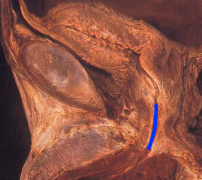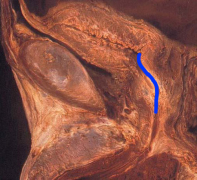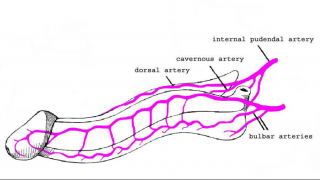The male urethra
| The urethra is a tubular structure that serves to bring to the exterior the urine contained in the bladder and seminal fluid from the prostate gland and seminal vescicles, which contains spermatozoa. The urethra originates in the bladder, at the inferior and anterior level, called bladder neck. After crossing the pelvic floor and the perineum, it runs along the entire length of the penis, ending at the apex of the gland. The length of the male urethra varies according to age and from person to person. In adult men, the length of the urethra, about 16-18 cm, varies also according to penile length. The male urethra can be subdivided into various tracts. |
Anterior and posterior urethra
| The male urethra is divided into the anterior and posterior urethra. The anterior urethra is divided into the navicularis, penile and bulbar urethra, and extends from the distal external urethral sphincter to the external urinary meatus. The posterior urethra can be divided into the membranous and prostatic urethra and consists of the segment that extends from the bladder neck to the distal external urethral sphincter. The posterior urethra includes the two urinary sphincters, at the level of the bladder neck (proximal urinary sphincter) and at the level of membranous urethra (distal urinary sphincter). |
Navicularis urethra
| The navicularis urethra extends inside the glans up to the external urinary meatus and is surrounded by the corpus spongiosum of the glans. Inside the navicularis urethra, the fossa navicularis and the Guerin’s valve can be found. |
Penile urethra
| The penile urethra extends from the peno-scrotal junction to the base of the glans. It is surrounded by the corpus spongiosum, is mobile and is stretched during penile erection The length of the penile urethra varies according to penile length. |
Bulbar urethra
| The bulbar urethra, located inside the perineum and scrotum, extends from the external distal urinary sphincter to the peno-scrotal junction, and is surrounded by the corpus spongiosum. It contains the opening of the ducts of the Cowper glands, and differs in length from person to person. |
Membranous urethra
| The membranous urethra is about 1.5 cm in length and is located inside the urogenital diaphragm. It is in anatomical relationship with the external distal urinary sphincter. |
Prostatic urethra
| The prostatic urethra is inside the prostate gland and extends from the bladder neck to the veru montanum. In the adult, the length of the prostatic urethra is about 3 cm, but in children it is shorter and in patients with prostatic enlargement it is longer. |
The urethra, from its origin in the bladder to its end at the apex of the penis, initially crosses the prostate, then exhibits a concave curve facing upwards and towards the pubic symphysis passing through the uro-genital diaphragm, which contains the external urethral or voluntary sphincter. It then penetrates the corpus spongiosum and finally runs along the entire length of the penis, this time forming a concave curve facing downwards and backwards.
Proceeding from the exterior towards the urethral lumen, the histological structure is constructed of a connective band created by a tunicae muscolaris in the proximal segment, by vascular lacunae (corpus spongiosum) in the distal part and by a mucous membrane.
The urethral mucous membrane is constructed of a multi-layered simple epithelium with multiple glands.
The blood vessels and nerves of the urethra originate predominantly from the collateral and terminal branches of the pudendal artery, veins and nerves. They are responsible for vascularisation and motor and sensory innervation of the organ.
| The urethra receives its anterograde blood supply from the bulbar arteries arising from the pudendal arteries and from the dorsal artery of the penis in retrograde fashion. |






